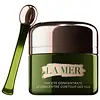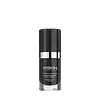What's inside
What's inside
 Key Ingredients
Key Ingredients

 Benefits
Benefits

 Concerns
Concerns

 Ingredients Side-by-side
Ingredients Side-by-side

Algae Extract
EmollientWater
Skin ConditioningDimethicone
EmollientIsododecane
EmollientGlycerin
HumectantHydrogenated Polyisobutene
EmollientTrisiloxane
Skin ConditioningCaprylic/Capric/Myristic/Stearic Triglyceride
EmollientVinyl Dimethicone/Methicone Silsesquioxane Crosspolymer
Caprylic/Capric Triglyceride
MaskingMaris Sal
Skin ConditioningYeast Extract
Skin ConditioningHelichrysum Arenarium Extract
AntiseborrhoeicSesamum Indicum Seed Oil
EmollientMedicago Sativa Seed Powder
Skin ConditioningHelianthus Annuus Seedcake
AbrasivePrunus Amygdalus Dulcis Seed Meal
AbrasiveEucalyptus Globulus Leaf Oil
PerfumingSodium Gluconate
Skin ConditioningCopper Gluconate
Skin ConditioningCalcium Gluconate
HumectantMagnesium Gluconate
Skin ConditioningZinc Gluconate
Skin ConditioningTocopheryl Succinate
AntioxidantNiacin
SmoothingSesamum Indicum Seed Powder
Skin ConditioningAsparagopsis Armata Extract
Skin ProtectingLaminaria Digitata Extract
Skin ProtectingSaccharum Officinarum Extract
MoisturisingPhytosphingosine
Skin ConditioningEcklonia Cava Extract
Skin ConditioningCorallina Officinalis Extract
Skin ConditioningSodium Hyaluronate
HumectantSigesbeckia Orientalis Extract
Skin ConditioningPolygonum Fagopyrum Seed Extract
Skin ConditioningBrassica Campestris Seed Oil
Skin ConditioningPolyglyceryl-3 Diisostearate
EmulsifyingGlycyrrhiza Glabra Root Extract
BleachingAscophyllum Nodosum Extract
Skin ConditioningCitrus Aurantifolia Peel Extract
CleansingCucumis Sativus Fruit Extract
EmollientAcetyl Hexapeptide-8
HumectantAlthaea Officinalis Root Extract
Skin ConditioningOryza Sativa Bran Extract
Skin ConditioningTocopheryl Acetate
AntioxidantSaccharomyces Lysate Extract
HumectantMacadamia Integrifolia Seed Oil
Skin ConditioningDipeptide-2
Skin ConditioningGlyceryl Triacetyl Ricinoleate
EmollientPalmitoyl Tetrapeptide-7
Skin ConditioningCaffeine
Skin ConditioningTetraacetylphytosphingosine
Skin ConditioningLactis Proteinum
Skin ConditioningAcetyl Glucosamine
Skin ConditioningTriethylhexanoin
MaskingSorbitol
HumectantHordeum Vulgare Extract
EmollientGlycine Soja Protein
EmulsifyingCholesterol
EmollientHydrolyzed Yeast Protein
Skin ConditioningIsononyl Isononanoate
EmollientPropylene Glycol Dicaprate
EmollientCetyl PEG/PPG-10/1 Dimethicone
EmulsifyingCaprylyl Glycol
EmollientSucrose
HumectantPolysilicone-11
Dimethicone Crosspolymer
Emulsion StabilisingDimethicone Crosspolymer-3
Skin ConditioningSilica
AbrasiveNylon-12
Trimethylsiloxysilicate
EmollientSteareth-20
CleansingCalcium Chloride
AstringentHesperidin Methyl Chalcone
AntioxidantPEG/PPG-18/18 Dimethicone
EmulsifyingAlumina
AbrasiveTriethoxycaprylylsilane
Hydrogenated Vegetable Oil
EmollientAlcohol Denat.
AntimicrobialPropanediol
SolventParfum
MaskingBHT
AntioxidantPhenoxyethanol
PreservativePotassium Sorbate
PreservativeChlorhexidine Digluconate
AntimicrobialSodium Benzoate
MaskingMica
Cosmetic ColorantCI 77891
Cosmetic ColorantAlgae Extract, Water, Dimethicone, Isododecane, Glycerin, Hydrogenated Polyisobutene, Trisiloxane, Caprylic/Capric/Myristic/Stearic Triglyceride, Vinyl Dimethicone/Methicone Silsesquioxane Crosspolymer, Caprylic/Capric Triglyceride, Maris Sal, Yeast Extract, Helichrysum Arenarium Extract, Sesamum Indicum Seed Oil, Medicago Sativa Seed Powder, Helianthus Annuus Seedcake, Prunus Amygdalus Dulcis Seed Meal, Eucalyptus Globulus Leaf Oil, Sodium Gluconate, Copper Gluconate, Calcium Gluconate, Magnesium Gluconate, Zinc Gluconate, Tocopheryl Succinate, Niacin, Sesamum Indicum Seed Powder, Asparagopsis Armata Extract, Laminaria Digitata Extract, Saccharum Officinarum Extract, Phytosphingosine, Ecklonia Cava Extract, Corallina Officinalis Extract, Sodium Hyaluronate, Sigesbeckia Orientalis Extract, Polygonum Fagopyrum Seed Extract, Brassica Campestris Seed Oil, Polyglyceryl-3 Diisostearate, Glycyrrhiza Glabra Root Extract, Ascophyllum Nodosum Extract, Citrus Aurantifolia Peel Extract, Cucumis Sativus Fruit Extract, Acetyl Hexapeptide-8, Althaea Officinalis Root Extract, Oryza Sativa Bran Extract, Tocopheryl Acetate, Saccharomyces Lysate Extract, Macadamia Integrifolia Seed Oil, Dipeptide-2, Glyceryl Triacetyl Ricinoleate, Palmitoyl Tetrapeptide-7, Caffeine, Tetraacetylphytosphingosine, Lactis Proteinum, Acetyl Glucosamine, Triethylhexanoin, Sorbitol, Hordeum Vulgare Extract, Glycine Soja Protein, Cholesterol, Hydrolyzed Yeast Protein, Isononyl Isononanoate, Propylene Glycol Dicaprate, Cetyl PEG/PPG-10/1 Dimethicone, Caprylyl Glycol, Sucrose, Polysilicone-11, Dimethicone Crosspolymer, Dimethicone Crosspolymer-3, Silica, Nylon-12, Trimethylsiloxysilicate, Steareth-20, Calcium Chloride, Hesperidin Methyl Chalcone, PEG/PPG-18/18 Dimethicone, Alumina, Triethoxycaprylylsilane, Hydrogenated Vegetable Oil, Alcohol Denat., Propanediol, Parfum, BHT, Phenoxyethanol, Potassium Sorbate, Chlorhexidine Digluconate, Sodium Benzoate, Mica, CI 77891
Water
Skin ConditioningIsopropyl Myristate
EmollientHydrogenated Vegetable Oil
EmollientGlycerin
HumectantCaprylic/Capric Triglyceride
MaskingGlyceryl Stearate
EmollientPEG-100 Stearate
PEG-40 Hydrogenated Castor Oil
EmulsifyingCetearyl Alcohol
EmollientPropanediol
SolventSodium Ascorbyl Phosphate
AntioxidantSodium Hyaluronate
HumectantPistacia Lentiscus Gum
MaskingCrataegus Monogyna Flower Extract
Skin ConditioningJasminum Sambac Flower Extract
MaskingHydroxypinacolone Retinoate
Skin ConditioningHelichrysum Stoechas Extract
TonicHaberlea Rhodopensis Leaf Extract
Skin ConditioningAcetyl Cysteine
AntioxidantEscin
TonicDiamond Powder
AbrasiveAesculus Hippocastanum Seed Extract
Skin ConditioningAloe Barbadensis Leaf Extract
EmollientCentella Asiatica Extract
CleansingGlycyrrhiza Glabra Root Extract
BleachingBenzyl Alcohol
PerfumingCaprylyl Glycol
EmollientOlea Europaea Fruit Oil
MaskingOryza Sativa Bran Oil
EmollientXanthan Gum
EmulsifyingEthylhexylglycerin
Skin ConditioningKaolin
AbrasiveAmmonium Acryloyldimethyltaurate/Vp Copolymer
Prunus Armeniaca Kernel Oil
MaskingDimethyl Isosorbide
SolventPentylene Glycol
Skin ConditioningLecithin
EmollientPolyglyceryl-6 Laurate
EmulsifyingCitric Acid
BufferingPolyglyceryl-10 Oleate
Skin ConditioningGlyceryl Caprylate/Caprate
EmollientSorbitan Palmitate
EmulsifyingSoy Isoflavones
Skin ConditioningBeta-Sitosterol
Emulsion StabilisingGlycosphingolipids
Emollient1,2-Hexanediol
Skin ConditioningSodium Benzoate
MaskingLactic Acid
BufferingPotassium Sorbate
PreservativeParfum
MaskingWater, Isopropyl Myristate, Hydrogenated Vegetable Oil, Glycerin, Caprylic/Capric Triglyceride, Glyceryl Stearate, PEG-100 Stearate, PEG-40 Hydrogenated Castor Oil, Cetearyl Alcohol, Propanediol, Sodium Ascorbyl Phosphate, Sodium Hyaluronate, Pistacia Lentiscus Gum, Crataegus Monogyna Flower Extract, Jasminum Sambac Flower Extract, Hydroxypinacolone Retinoate, Helichrysum Stoechas Extract, Haberlea Rhodopensis Leaf Extract, Acetyl Cysteine, Escin, Diamond Powder, Aesculus Hippocastanum Seed Extract, Aloe Barbadensis Leaf Extract, Centella Asiatica Extract, Glycyrrhiza Glabra Root Extract, Benzyl Alcohol, Caprylyl Glycol, Olea Europaea Fruit Oil, Oryza Sativa Bran Oil, Xanthan Gum, Ethylhexylglycerin, Kaolin, Ammonium Acryloyldimethyltaurate/Vp Copolymer, Prunus Armeniaca Kernel Oil, Dimethyl Isosorbide, Pentylene Glycol, Lecithin, Polyglyceryl-6 Laurate, Citric Acid, Polyglyceryl-10 Oleate, Glyceryl Caprylate/Caprate, Sorbitan Palmitate, Soy Isoflavones, Beta-Sitosterol, Glycosphingolipids, 1,2-Hexanediol, Sodium Benzoate, Lactic Acid, Potassium Sorbate, Parfum
 Reviews
Reviews

Ingredients Explained
These ingredients are found in both products.
Ingredients higher up in an ingredient list are typically present in a larger amount.
This ingredient is an emollient, solvent, and texture enhancer. It is considered a skin-softener by helping the skin prevent moisture loss.
It helps thicken a product's formula and makes it easier to spread by dissolving clumping compounds.
Caprylic Triglyceride is made by combining glycerin with coconut oil, forming a clear liquid.
While there is an assumption Caprylic Triglyceride can clog pores due to it being derived from coconut oil, there is no research supporting this.
Learn more about Caprylic/Capric TriglycerideCaprylyl Glycol is a humectant and emollient, meaning it attracts and preserves moisture.
It is a common ingredient in many products, especially those designed to hydrate skin. The primary benefits are retaining moisture, skin softening, and promoting a healthy skin barrier.
Though Caprylyl Glycol is an alcohol derived from fatty acids, it is not the kind that can dry out skin.
This ingredient is also used as a preservative to extend the life of products. It has slight antimicrobial properties.
Learn more about Caprylyl GlycolGlycerin is already naturally found in your skin. It helps moisturize and protect your skin.
A study from 2016 found glycerin to be more effective as a humectant than AHAs and hyaluronic acid.
As a humectant, it helps the skin stay hydrated by pulling moisture to your skin. The low molecular weight of glycerin allows it to pull moisture into the deeper layers of your skin.
Hydrated skin improves your skin barrier; Your skin barrier helps protect against irritants and bacteria.
Glycerin has also been found to have antimicrobial and antiviral properties. Due to these properties, glycerin is often used in wound and burn treatments.
In cosmetics, glycerin is usually derived from plants such as soybean or palm. However, it can also be sourced from animals, such as tallow or animal fat.
This ingredient is organic, colorless, odorless, and non-toxic.
Glycerin is the name for this ingredient in American English. British English uses Glycerol/Glycerine.
Learn more about GlycerinGlycyrrhiza Glabra Root Extract is an extract of the roots of Licorice. It has been found to have several benefits such as skin hydrating, conditioning, and soothing.
One component, glabridin, has extra potent antioxidant and soothing properties. It has also been found to block pigmentation from UVB rays in guinea pigs.
Licorice Root also contains a flavonoid. Flavonoids are a natural substance from in plants. Flavonoids also have antioxidant properties.
Another component, glycyrrhizin, has been found to have anti-inflammatory and antimicrobial benefits. This may make licorice root extract effective at treating acne. However, more research is needed to support this.
Liquiritin is one of the flavone compounds found in licorice. It has been found to help lighten skin by preventing tyrosinase from reacting with tyrosine. When the two react, protein is converted to melanin. Melanin is the substance in your body that gives your features pigmentation.
Learn more about Glycyrrhiza Glabra Root ExtractHydrogenated Vegetable Oil is created by adding hydrogen to vegetable oil in order to give it more stability. This process also raises the melting point of vegetable oil. In cosmetics, it is an emollient.
Emollients help soothe and soften the skin. They do this by creating a protective film on your skin. This barrier helps trap moisture and keeps your skin hydrated. Emollients may be effective at treating dry or itchy skin.
The term "Hydrogenated Vegetable Oil" is an umbrella term and can refer to a variety of vegetable oils and blends of: sunflower oil, soybean oil, olive oil, coconut oil, palm oil, and more.
Due to the differences in vegetables, the benefits may vary.
Learn more about Hydrogenated Vegetable OilParfum is a catch-all term for an ingredient or more that is used to give a scent to products.
Also called "fragrance", this ingredient can be a blend of hundreds of chemicals or plant oils. This means every product with "fragrance" or "parfum" in the ingredients list is a different mixture.
For instance, Habanolide is a proprietary trade name for a specific aroma chemical. When used as a fragrance ingredient in cosmetics, most aroma chemicals fall under the broad labeling category of “FRAGRANCE” or “PARFUM” according to EU and US regulations.
The term 'parfum' or 'fragrance' is not regulated in many countries. In many cases, it is up to the brand to define this term.
For instance, many brands choose to label themselves as "fragrance-free" because they are not using synthetic fragrances. However, their products may still contain ingredients such as essential oils that are considered a fragrance by INCI standards.
One example is Calendula flower extract. Calendula is an essential oil that still imparts a scent or 'fragrance'.
Depending on the blend, the ingredients in the mixture can cause allergies and sensitivities on the skin. Some ingredients that are known EU allergens include linalool and citronellol.
Parfum can also be used to mask or cover an unpleasant scent.
The bottom line is: not all fragrances/parfum/ingredients are created equally. If you are worried about fragrances, we recommend taking a closer look at an ingredient. And of course, we always recommend speaking with a professional.
Learn more about ParfumPotassium Sorbate is a preservative used to prevent yeast and mold in products. It is commonly found in both cosmetic and food products.
This ingredient comes from potassium salt derived from sorbic acid. Sorbic acid is a natural antibiotic and effective against fungus.
Both potassium sorbate and sorbic acid can be found in baked goods, cheeses, dried meats, dried fruit, ice cream, pickles, wine, yogurt, and more.
You'll often find this ingredient used with other preservatives.
Learn more about Potassium SorbatePropanediol is an all-star ingredient. It softens, hydrates, and smooths the skin.
It’s often used to:
Propanediol is not likely to cause sensitivity and considered safe to use. It is derived from corn or petroleum with a clear color and no scent.
Learn more about PropanediolSodium Benzoate is a preservative. It's used in both cosmetic and food products to inhibit the growth of mold and bacteria. It is typically produced synthetically.
Both the US FDA and EU Health Committee have approved the use of sodium benzoate. In the US, levels of 0.1% (of the total product) are allowed.
Sodium benzoate works as a preservative by inhibiting the growth of bacteria inside of cells. It prevents the cell from fermenting a type of sugar using an enzyme called phosphofructokinase.
It is the salt of benzoic acid. Foods containing sodium benzoate include soda, salad dressings, condiments, fruit juices, wines, and snack foods.
Studies for using ascorbic acid and sodium benzoate in cosmetics are lacking, especially in skincare routines with multiple steps.
We always recommend speaking with a professional, such as a dermatologist, if you have any concerns.
Learn more about Sodium BenzoateSodium Hyaluronate is hyaluronic acid's salt form. It is commonly derived from the sodium salt of hyaluronic acid.
Like hyaluronic acid, it is great at holding water and acts as a humectant. This makes it a great skin hydrating ingredient.
Sodium Hyaluronate is naturally occurring in our bodies and is mostly found in eye fluid and joints.
These are some other common types of Hyaluronic Acid:
Learn more about Sodium HyaluronateWater. It's the most common cosmetic ingredient of all. You'll usually see it at the top of ingredient lists, meaning that it makes up the largest part of the product.
So why is it so popular? Water most often acts as a solvent - this means that it helps dissolve other ingredients into the formulation.
You'll also recognize water as that liquid we all need to stay alive. If you see this, drink a glass of water. Stay hydrated!
Learn more about Water